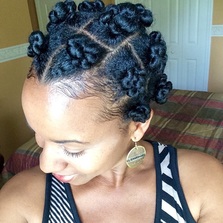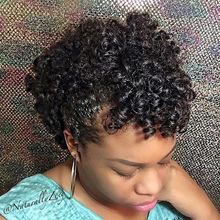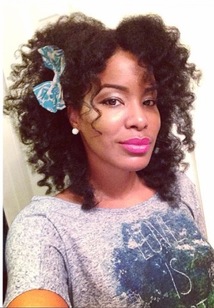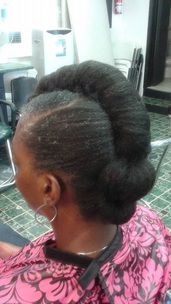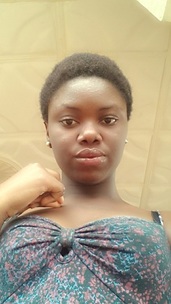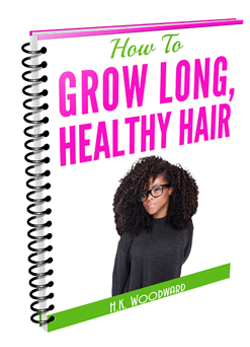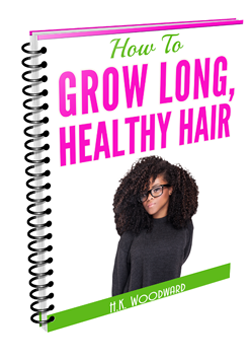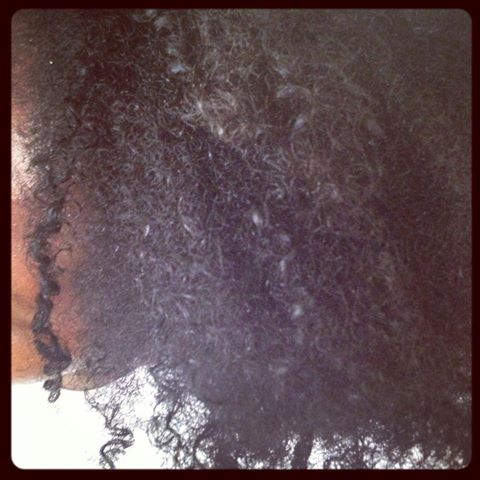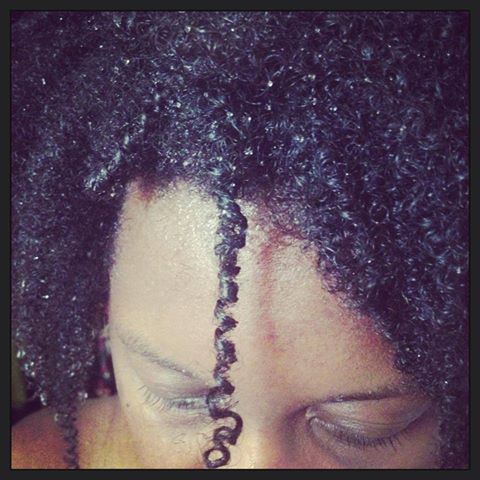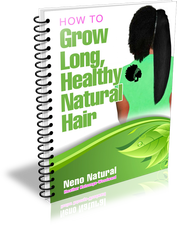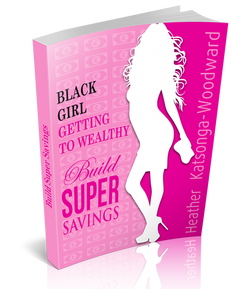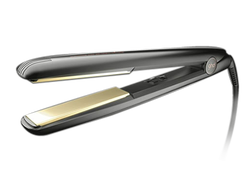
The answer will annoy you! It depends. Some hair types are stronger and can take more heat than others but there are some general rules that apply to all hair types.
Firstly, when you apply heat to your hair it loses both water and protein. In order to straighten hair, the bonds within each fibre have to break. This same bond breakage also happens when hair is chemically relaxed. However, whereas chemical relaxers break the bonds in hair permanently, heat usually breaks the bonds temporarily and the process is reversed by immersing the hair in water. So what does heat damage look like? Heat damage normally happens to some bits of hair and not others so when you wash it there are some odd straight hairs here and there mixed in with the curly hair. The straight hairs are the heat damaged hair fibres - that hair will not curl back. The regularity with which you can use heat depends on:
Heat damage is cumulative: the more you use heat, the worse the state of your hair gets. Just because your hair dealt with heat well this week, it doesn't mean it will do well next week. Blow drying and pressing increases the incidence of split ends and general breakage so if you use heat regularly you can expect to have to trim more regularly. Overall, even if you have thick course hair I would recommend that you use heat only once a week at the most. If your hair is fine, once or twice a month is plenty. An alternative to direct heat application is to use hair rollers or curl formers and apply heat at a safe distance using a hooded dryer as the preferred option and a blow dryer as a next-best option. Direct application including blow drying using dryers with a comb is much more damaging than applying heat from a distance. Importantly, before applying heat ensure your hair has been washed, deep conditioned and moisturized adequately. You can get the Queen of Kinks product line on Amazon USA and Amazon UK. If you're Prime Member you'll get it super fast. 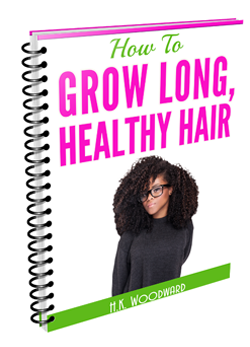
Get your FREE ebook on How To Grow Long, Healthy Natural Kinky or Curly Hair. Ref: The Science of Black Hair, pages 168 - 170 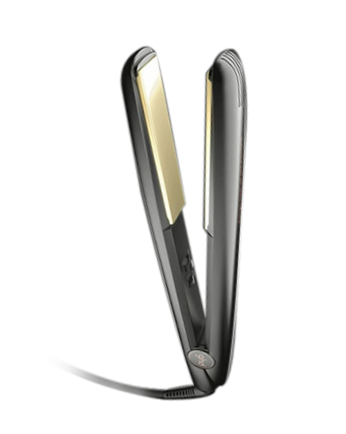
CHI stands for Ceramic Heating Iron.
CHI is not a brand name and can be applied to any flatiron that uses ceramic plates. The Farouk CHI flatiron is a leading brand in the flatiron space in America, however, not every CHI flatiron belongs to the Farouk brand. Retailers sometimes prey on customers that don't realise that not all CHI flatirons are Farouk by charging an unnecessary premium on all CHI products. What are the benefits of ceramic plates? Ceramic plates are superior to metal plates because they transfer heat more rapidly, more evenly and the level of heat can be regulated better so they are likely to straighten hair better and with the least heat damage. 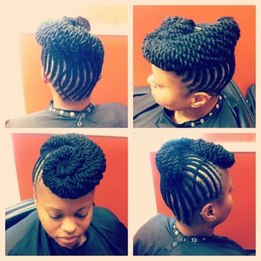
Is the plate 100% ceramic?
No. In order to create heat metal is needed. Most ceramic irons have aluminium as the base plate and several ceramic layers on top of that. Cheaper ceramic irons will only have a thin ceramic layer which gets eroded after a few months. When should you replace your ceramic iron? If you see that the surface of your ceramic iron is uneven, then it's likely that the ceramic layer has been (partly) eroded so it's best to replace it. An uneven surface will also mean uneven heating as some spots on the iron will get hotter than others. This will increase the likelihood of heat damage and even hair breaking as it gets caught on the eroding plate and snags.
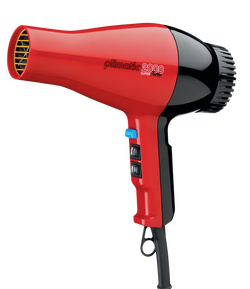
A while ago I went to get my hair braided and the stylist told me that I don't have "the type of hair that can live without blow-drying". She said my hair needed the blow dry to reduce tangles. I had already concluded that she knew nothing about naturally curly hair but her statement did get me thinking.
At the time, I hadn't blow dried my hair in over a year and after shoulder length I found that tangles are a massive problem if you don't have tangle coping strategies. I'm still resistant to blow drying on a regular basis because I don't want to get heat damage but over time I have become comfortable with blow drying my hair whenever I get plaits at a salon. This is roughly every 3 to 4 months. This is what my research on how to blow dry curly hair more gently taught me... Top tips for blow drying hair gently:
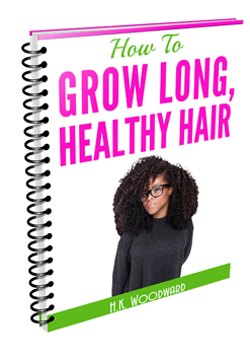
Get your FREE ebook on How To Grow Long, Healthy Natural Kinky or Curly Hair. 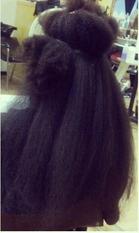 I actually didn't realise there were so many techniques for blow drying hair. I haven't blow dried my hair since about May 2011. Since then, I've had my hair blow dried twice: on my wedding day, 11.11.11 and at the beginning of January when I braided my hair. I'm working on building my confidence to blow dry my own hair again. My goal with blow drying is to detangle more effectively; straightening my hair is not a key goal at all. Before you blow dry, however, here are 9 tips for how to blow dry natural black hair gently. The most impotant tips are to detangle well before the blow dry and to ensure it's strong, i.e. well conditioned and sealed. The Tension Method (Blow Drying Natural Hair)This is the gentlest technique for blow drying hair because it doesn't make use of a comb. This wouldn't do justice to my very coily, thick, course 4C hair; I would need to keep detangling with a comb as I blow dried. Below, she seals with grapeseed oil. A top ingredient in our Hair Growth Stimulator. The Modified Tension Method (Blow Drying Hair)The only difference here is that you make greater use of a wide-tooth comb or a brush to detangle and smooth the hair down a little further. In the below video she blow dries her ends but personally, I would keep the blow dryer of hair ends because they are the weakest section of hair. The Comb Attachment Method (Blow Drying Hair)This involves blow drying hair using a blow dryer that has a comb attached to the end of it. Most hair salon I've been to use this technique. I can't find a decent video but this one will do until I make my own! The Round Brush Method (Blow Drying Natural Hair)This involves blow drying hair using a rounded brush. It's the least gentle of the 4 methods. It produces the straightest hair and the most volume. I think this is a little too intense. A better idea is to roll your hair using hair rollers and blow dry the surface gently or use a hooded dryer. 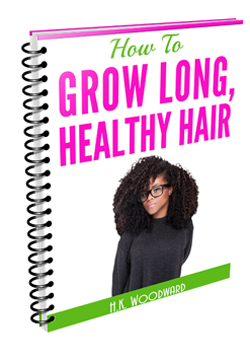 Get your FREE ebook on How To Grow Long, Healthy Natural Kinky or Curly Hair. 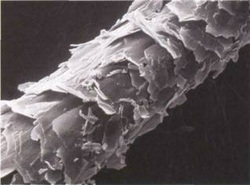 A damaged hair cuticle A damaged hair cuticle
I washed my hair 6 hours ago and it's still wet!
Granted, I have been wearing a beany hat all day and it is in plaits but even when it's loose my hair does take a long time to dry. The key driver of the rate at which hair dries is its porosity. Porosity refers to how easily water and other chemicals can diffuse into and out of hair. If the outer layer of the hair fibre, the cuticle, is very tightly bound and lies very flat the hair is not very porous. This type of hair is quite resistant to the entry and exit of chemicals including water. If the cuticle layer of hair has been damaged, it's weak and much more porous. Porous hair dries much more quickly than non-porous hair. Porous hair once moisturised loses that moisture much more quickly than hair that is not porous. 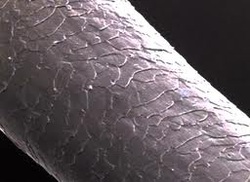 A damaged hair cuticle A damaged hair cuticle
Other environmental and external factors influence the rate at which hair dries:
According to The Science of Black Hair, an intensely hot blow dry for a short period of time (10 - 20 minutes) is far more damaging than much milder heat application for a longer period of time, e.g. sitting under a hooded dryer for 45 minutes. Keep these factors in mind when you want your to dry fast! 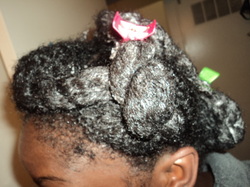
To ensure you absorb all the good stuff from a deep conditioner many recommend that you apply heat over a shower cap or sit under a hooded dryer with hair covered in a plastic shower cap.
Why doesn't this cause heat damage? The reasons are simple: 1. Heat is not direct The heat is not applied directly to the hair, it's over a shower cap so it is much less intense. 2. The conditioner creates a protective seal At the time you apply heat, your hair is covered in the conditioner and that in itself acts as a strong heat protectant. 3. Water's "specific heat" temperature is very high The specific heat is the amount of heat required to raise the temperature of a given quantity of 'something' by one degree Celsius. A lot of energy is need to increase the temperate of water by one degree. Conditioner's key ingredient is water. Water acts as a buffer between the heat and your hair and slows down the rate at which your hair fibres take in the heat. It also follows that if your hair is very well moisturised, sealed (e.g. with coconut oil or an oil blend) and has been recently deep conditioned, styling tools that use heat are much less likely to cause heat damage. 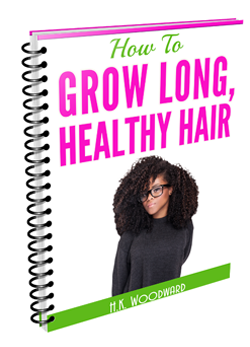
Get your FREE ebook on How To Grow Long, Healthy Natural Kinky or Curly Hair. Ref: The Science of Black Hair, pages 171-2 |
I now blog about wealth creation - so if you have any money questions meet me there, you can do all sorts of cool things like leave me a voicemail.
By Heather Katsonga-Woodward
I was a natural hair blogger and mixtress living between London & Chicago from 2012 to 2017. I always thought I was 4C but some say 4B; images below - you decide! Heather xx Categories
All
Archives
November 2016
|

